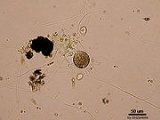
Suctoria
Encyclopedia
Suctoria are sessile ciliate
s which feed by extracellular digestion and lack cilia in the adult phase. They were originally thought to feed by suction – hence their name. In fact, they use specialized microtubules to ensnare and manipulate their prey. They are found in both freshwater and marine environments, including some which live on the surface of aquatic animals, and typically feed on other ciliates. Instead of a single cytostome
, each cell feeds by means of several specialized tentacles. These are supported by microtubules and phyllae, and have toxic extrusome
s called haptocysts at the tip which attach to prey. Its cytoplasm is then sucked directly into a food vacuole
inside the cell, where its contents are digested and absorbed. Most suctoria are around 15-30 μm in size, with a non-contractile stalk and often a lorica
or shell.
 Suctoria reproduce primarily by budding, producing swarmers which lack both tentacles and stalks but have cilia. They may also reproduce through conjugation, which is peculiar in involving cells of different size and often involves total fusion. The way in which buds are formed is the primary way the different orders of suctoria are distinguished. Among the Exogenida, including common genera like Podophrya and Sphaerophrya, they appear directly on the cell surface. Among the Endogenida, for instance Tokophrya and Acineta, they are formed in an internal pouch and escape through an opening, and among the Evaginogenida, they are formed in a pouch that inverts before they are released.
Suctoria reproduce primarily by budding, producing swarmers which lack both tentacles and stalks but have cilia. They may also reproduce through conjugation, which is peculiar in involving cells of different size and often involves total fusion. The way in which buds are formed is the primary way the different orders of suctoria are distinguished. Among the Exogenida, including common genera like Podophrya and Sphaerophrya, they appear directly on the cell surface. Among the Endogenida, for instance Tokophrya and Acineta, they are formed in an internal pouch and escape through an opening, and among the Evaginogenida, they are formed in a pouch that inverts before they are released.
Once the swarmers have found a place to attach themselves, they quickly develop stalks and tentacles. The cilia are lost, but the underlying infraciliature persists throughout the entire life-cycle. This has a structure which, together with other ultrastructural similarities, places the suctoria within the class Phyllopharyngea
.
Ciliate
The ciliates are a group of protozoans characterized by the presence of hair-like organelles called cilia, which are identical in structure to flagella but typically shorter and present in much larger numbers with a different undulating pattern than flagella...
s which feed by extracellular digestion and lack cilia in the adult phase. They were originally thought to feed by suction – hence their name. In fact, they use specialized microtubules to ensnare and manipulate their prey. They are found in both freshwater and marine environments, including some which live on the surface of aquatic animals, and typically feed on other ciliates. Instead of a single cytostome
Cytostome
A cytostome or cell mouth is a part of a cell specialized for phagocytosis, usually in the form of a microtubule-supported funnel or groove. Food is directed into the cytostome, and sealed into vacuoles. Only certain groups of protozoa, such as the ciliates and excavates, have cytostomes. Such...
, each cell feeds by means of several specialized tentacles. These are supported by microtubules and phyllae, and have toxic extrusome
Extrusome
Extrusomes are membrane-bound structures in some eukaryotes which, under certain conditions, discharge their contents outside the cell. There are a variety of different types, probably not homologous, and serving various functions....
s called haptocysts at the tip which attach to prey. Its cytoplasm is then sucked directly into a food vacuole
Vacuole
A vacuole is a membrane-bound organelle which is present in all plant and fungal cells and some protist, animal and bacterial cells. Vacuoles are essentially enclosed compartments which are filled with water containing inorganic and organic molecules including enzymes in solution, though in certain...
inside the cell, where its contents are digested and absorbed. Most suctoria are around 15-30 μm in size, with a non-contractile stalk and often a lorica
Lorica (biology)
In biology, a lorica is a shell-like protective outer covering, often reinforced with sand grains and other particles that some protozoans and loricifera metazoans secrete. Usually it is tubular or conical in shape, with a loose case that is closed at one end. An example is the protozoan genus...
or shell.

Once the swarmers have found a place to attach themselves, they quickly develop stalks and tentacles. The cilia are lost, but the underlying infraciliature persists throughout the entire life-cycle. This has a structure which, together with other ultrastructural similarities, places the suctoria within the class Phyllopharyngea
Phyllopharyngea
The Phyllopharyngea are a class of ciliate protozoa, including some which are extremely specialized. Motile cells typically have cilia restricted to the ventral surface, or some part thereof, arising from monokinetids with a characteristic ultrastructure...
.

